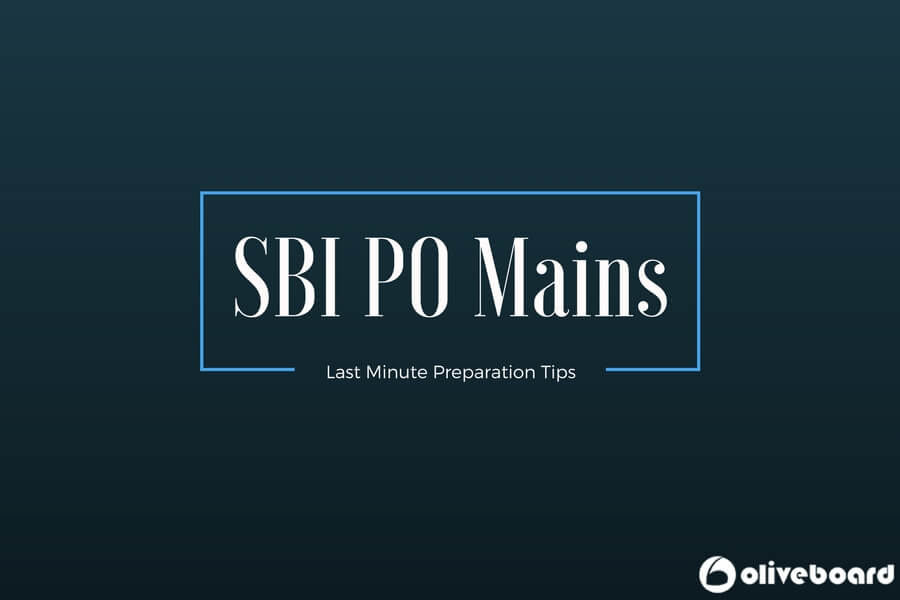SBI PO Mains is primarily an objective test, with 4 sections, containing 155 questions for a total of 200 marks and a descriptive test in letter and essay writing for 50 marks. The exam has sectional timing. Except the English Language section, every section will be available in Hindi as well as English.
With hardly 14 days left for the exam, we hope your preparation is in full swing. The following article provides last minute preparation tips, to help you give your preparation a final touch.
SBI PO 2017 Mains Exam Pattern
(i) Objective test
| Sr. No | Name of the section | No of questions | Marks | Duration |
| 1 | Reasoning & Computer Aptitude | 45 | 60 | 60 minutes |
| 2 | Data Analysis & Interpretation | 35 | 60 | 45 minutes |
| 3 | General/Economy/Banking Awareness | 40 | 40 | 35 minutes |
| 4 | English Language | 35 | 40 | 40 minutes |
| Total | 155 | 200 | 180 minutes | |
(ii) English Language Descriptive Test: Letter Writing & Essay
Marks: 50 Marks
Duration: 30 Minutes
Candidates are supposed to clear descriptive test by securing passing marks, to be decided by the Bank.
Reasoning and Computer Aptitude
Important topics:
- Verbal Reasoning (5-10 Questions)
- Analytical Decision Making (4-5 Questions)
- Computer Aptitude (5-7 Questions)
- Ordering & Ranking (2-3 Questions)
- Coding Decoding (3-5 Questions)
- Double lineup (5-10 Questions)
- Coded inequalities (3-5 Questions)
- Grouping and Scheduling (3-5 Questions)
- Syllogism (3-5 Questions)
- Circular Seating Arrangement (5 Questions)
- Machine Input Output (3-5 Questions)
- Linear Seating Arrangement (0-5 Questions)
- Data Sufficiency (3-5 Questions)
- Direction and Distance (1-2 Questions)
- Blood Relations (3-4 Questions)
- The Reasoning & Computer Aptitude section tests your problem-solving & decision making skills. It’s important that you glance through the paper and make a quick decision about which questions to attempt first and which can wait. To master Reasoning & Computer Aptitude, you need to practice at least 2-3 hours every day.
- Practice diverse types of puzzles and seating arrangement questions every day for Reasoning and number conversions in Computer Aptitude. The questions under the Computer Aptitude section may be presented in the form of number systems, binary logic, flow charts, etc.
- If you want to clear the sectional cut off of the Reasoning section, focus on mastering these topics: Syllogism, Data Sufficiency, Coded inequalities, Coding decoding, and, Machine input output. These topics together constitute around 20-25 marks.
- There might be approximately 10 questions from the Verbal Reasoning topic, that include Statement & Assumption, Statement & Arguments, Statement & Inference, Critical Reasoning, Cause & Effect and Course of Action.
- For blood relations, start with basic problems and then move on to advanced. You can expect around 2-4 questions from this topic including, Family Tree Problems, Coded Blood Relations and Statement based problems.
- Another important, yet time-consuming topic under the Reasoning section is the Puzzles. Solving Puzzles takes a considerate amount of time, so, we suggest you time yourself and practice as many diverse puzzles as possible, using shortcut techniques and other tricks. Some of the topics include, Circular Arrangement, Grouping & Scheduling, Double Lineup, Linear Arrangement and Order and Ranking.
- Another topic that requires you to solve quickly is the Direction & Distance. Time yourself during your practice and try to solve at least 2 questions within 5 minutes.
Data Analysis and Interpretation
Important topics:
- Graphs (Tabular, Line, Pie, Radar, Bar)
- Caselets
- Missing DI
- Data Sufficiency
- Permutations & Combinations
- Mensuration
- Simple Interest Compound Interest
- Boats & Steams
- Profit & Loss
- Ages
- Probability
- The Data Analysis & Interpretation is one of the most scoring sections of the SBI PO 2017 Main exam. Dedicate at least 2-3 hours of practice to this section on a daily basis. This section tests the way you approach and analyze/interpret the given information/data.
- In Data Analysis & Interpretation, try and solve the easier questions first, and then move on to the more difficult ones. For example, for Data Interpretation, solve the questions with less number of variables before moving on to the other sets, as this is less time-consuming. You can expect at least 2 to 3 easy and less time-consuming questions under Data Interpretation.
- Go through the given graphs or data carefully, before starting to solve them. Note down the given information in a neat, clean and well-structured format.
- Practice diverse types of Data Interpretation questions, such as, the Bar Graph, Caselets, Missing DI, Pie Charts, Radar Graph, Mixed Graph, and Tabular Graph.
- As much as possible try to make mental calculations to save time during the exam.
General/economy/banking awareness
Topics:
- Current Affairs (11-12 questions)
- Static GK (15-16 questions)
- Banking & Financial Awareness (14-15 questions)
- It goes without saying, that to master this section you should be aware of the latest happenings around you. It’s important that you read newspaper on a daily basis. Merely reading newspaper isn’t enough; Make notes from the newspapers and revise them regularly.
- For current affairs, go through National and International news of the past 6 months (Preferably from The Hindu newspaper and magazines like Yojana and Pratiyogita Darpan), especially on topics like: Sports, Politics, Geography, Art & Culture, Economy, Science & Technology, etc.
- The Banking & Financial Awareness part requires you to have an understanding of the various Banking and Finance terminologies, Changes in growth rate of the different parts of economy (Agriculture, Ex-Im, other industries), Macro and Micro financing institutions in the country, Reforms in the Monetary policies of RBI (since last year), abbreviations and full-forms, Macro and Micro economic concepts (Foreign trade, CAD), Reforms since the last 2 years, the 2017 Union Budget, the various policies, Financial Institutions (International and National), Facts & Figures, Guidelines, Names of various banks, their chairpersons, headquarters and taglines, Financial Committees, etc.
- Static GK: The Static GK part, will have questions on important dams in India, Sports and their trophies, important sports stadiums, national parks and wildlife sanctuaries, countries, capitals and their currencies, historical monuments, airports and seaports, forts, etc.
English Language
Important topics:
- Reading Comprehension (14-15 Questions)
- Fill in the Blanks (5 Questions)
- Sentence jumbles/Odd man out/Paragraph completion/Parajumbles/Sentence Completion (5-10 Questions)
- Cloze Test (0-6 Questions)
- Error Spotting (0-5 Questions)
- Word Association (0-6 Questions)
- To master the English Language section, you need to be thorough in your Grammar concepts and rules and Vocabulary. The questions in this section are broadly based on those two aspects.
- To improve your vocabulary, learn new words every day and use them in your conversations.
- Another important topic is the Reading Comprehension. This is one of the most scoring topics in the English Language section, which can sometimes help you clear your sectional cut offs. The Reading Comprehension passages come from diverse topics such as, Economy, Governance, Education, Business, Technology, Geo-Politics, Social Issues, Transport etc. So, it’s important that you read a variety of text from Newspapers, Magazines, Novels, etc.
- During your exam, try and attempt at least 2 sets of Reading Comprehension questions within 20 minutes.
- Some of the topics under English Language contain questions with a twist. Especially the Fill in the Blanks, Error Spotting and the Cloze Test topics. Be cautious and pay close attention to the passages, read the questions carefully before answering.
- The Word association topic, tests your knowledge of identifying the relation between words. The words could be opposites/synonyms/antonyms, etc. A good knowledge in vocabulary will help you solve these questions quickly. You can expect around 6 questions from this section, though sometimes this topic may be omitted.
Mock Tests
While it is important to study the concepts and practice questions from the different sections, it is equally important to take Mock Tests.
Mock Tests are a big part of the SBI PO Exam preparation. Taking Mock Tests will help you analyze your performance, identify your strong and weak areas, determine your speed and accuracy, measure your progress.
Follow these steps to measure your study progress using mock tests:
Step 1: Take an SBI PO Mock Test.
Step 2: Analyze your performance, i.e., determine your speed & accuracy across the topics, identify your strong & weak areas.
Step 3: Practice sufficient number of questions from your weak areas. It’s a good idea to set a timer during your practice sessions. Try and solve the questions as quickly and as accurately as possible.
Step 4: Post-practice, take another SBI PO Mock Test to check for improvements.
Keep repeating steps 1 to 4, till you have achieved a good speed & accuracy across all the topics.
General tips
Quizzes: There are hundreds of free daily quizzes on topics like Banking Awareness, Static GK Awareness, Current Affairs, Financial Awareness, English Language, Reasoning, Quant, etc. Take out 30-40 minutes every day to take these online quizzes to improve your knowledge.
Click here to take Oliveboard’s Daily Online Quizzes
Previous year question papers: Go through and analyze the previous year SBI PO Mains question papers. Analyzing previous year question papers will give you a fair idea about the pattern of questions.
Cutoffs: SBI PO Mains has sectional as well as overall cut offs. You need to clear both of them to qualify for the group exercises & interview round. Attempt enough questions with great accuracy from your weaker sections to clear the sectional cut off of that section. Use your stronger sections to score more and increase your overall cut off marks.
Negative marking: There’s negative marking in the objective test. Every wrong answer has a negative mark of 0.25 of the weightage of that question.
Use the above as a guideline to add final touches to your SBI PO 2017 Main Exam Preparation.
We wish you all the very best.
Further reading:
SBI PO Mains: How to Approach the Descriptive Section
Basic Approach for Puzzles Analytical Reasoning
Govind Upadhyays Strategy to Crack SBI PO
Debasmita’s Strategy to Crack SBI PO
Strategy to Solve Coding Decoding
Strategy to Solve Floor Based Puzzles
How to Multiply 2-digit Numbers in Mind

The most comprehensive online preparation portal for MBA, Banking and Government exams. Explore a range of mock tests and study material at www.oliveboard.in
Oliveboard Live Courses & Mock Test Series



